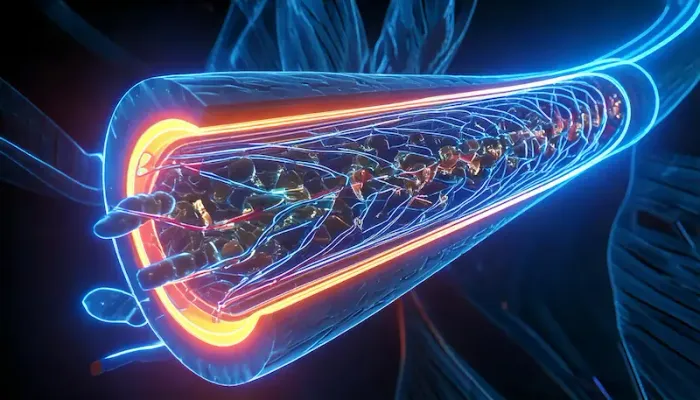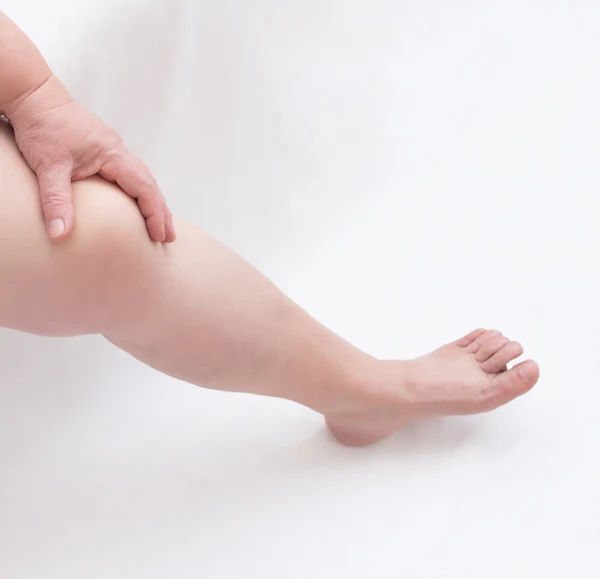Guide to Advanced Laser Catheter For Blocked Arteries
Learn how advanced laser catheters treat complex artery blockages with precision. Discover the procedure, benefits, risks, and recovery for improved heart health.

Written by Dr. Mohammed Kamran
Reviewed by Dr. Rohinipriyanka Pondugula MBBS
Last updated on 29th Sep, 2025

Introduction
For millions, blocked arteries are a silent threat, raising the risk of heart attacks and strokes. While most people are familiar with stents and bypass surgery, an advanced technology is revolutionising treatment for complex cases: the laser catheter. Imagine a tool so precise it can vaporise dangerous plaque blockages with a beam of light, restoring blood flow without major surgery. This isn't science fiction; it's a medical reality known as laser angioplasty or atherectomy. This guide will demystify this advanced procedure, explaining how it works, who it's for, and what you can expect. If you or a loved one is facing a diagnosis of severe artery disease, understanding this option can empower you to have an informed discussion with your cardiologist.
What is a Laser Catheter and How Does It Clear Blockages?
A laser catheter is a thin, flexible tube that is threaded through your blood vessels to the site of a blockage. At its tip is a device that emits pulses of concentrated light energy. Unlike the burning lasers of movies, this is a "cold" laser, specifically an Excimer laser, which works by breaking the molecular bonds of the plaque without generating significant heat that could damage the artery wall. Think of it as using targeted light energy to dissolve the obstacle piece by piece.
The Science Behind the Light: How Cold Laser Energy Works
The term "cold laser" can be misleading. The Excimer laser used in procedures like Excimer laser coronary angioplasty (ELCA) produces ultraviolet light in extremely short pulses (billionths of a second). This precise energy is absorbed by the plaque within a microscopic layer—about the width of a human cell—causing it to vaporise into tiny gaseous particles that are safely expelled by the body. This ablative process is highly controlled, allowing your interventional cardiologist to remove the blockage with remarkable precision, minimising trauma to the healthy parts of the artery.
Laser Atherectomy vs. Traditional Balloon Angioplasty: A Key Difference
It's crucial to understand that laser atherectomy is not always a replacement for traditional angioplasty but often a complementary tool. In a standard balloon angioplasty, a balloon is inflated at the blockage site to compress the plaque against the artery wall, creating a wider channel for blood flow. A stent is then often placed to keep it open.
However, some blockages are too hard, too long, or located in a way that makes them resistant to simple balloon compression. This is where the laser catheter shines. It is frequently used before ballooning and stenting to debulk or remove a significant portion of the tough plaque, making the subsequent steps safer and more effective. It's like clearing a path through dense rubble before widening the road.
Consult a Cardiologist for the best advice
When is a Laser Catheter the Right Choice? Key Medical Scenarios
This advanced technology is not the first-line treatment for every blocked artery. It is typically reserved for specific, challenging situations where conventional methods are likely to be less effective or carry higher risks.
Tackling Stubborn Calcium: The Challenge of Hardened Plaque
Over time, plaque in arteries can become hardened with calcium, creating a substance as tough as bone. This calcified plaque is difficult to expand with a balloon and can prevent a stent from deploying fully or evenly. An under-expanded stent is a primary risk factor for future failure. A laser catheter is exceptionally effective at ablating this calcified material, creating a better environment for a successful stent placement.
Solving In-Stent Restenosis: When a Previously Placed Stent Gets Clogged
Sometimes, a previously placed stent can become clogged with new tissue growth, a condition known as in-stent restenosis. Treating this can be tricky because inflating a balloon inside the existing stent often pushes the tissue aside temporarily, only for it to grow back. The laser energy, however, can vaporise the tissue growing within the stent mesh, providing a more durable solution by removing the material rather than just displacing it.
Treating Long or Total Blockages (Chronic Total Occlusions)
Chronic total occlusions (CTOs) are arteries that have been 100% blocked for an extended period (typically over three months). These are among the most complex challenges in interventional cardiology. The laser catheter can be used to help cross these tough blockages or to modify the plaque composition before stenting, increasing the success rate of these intricate procedures. If you have been diagnosed with a complex blockage like a CTO, consulting a specialist is crucial. You can book a physical visit to a leading cardiologist with Apollo24|7 to discuss all your treatment options.
The Step-by-Step Laser Angioplasty Procedure
Understanding the procedure can alleviate much of the anxiety associated with it. It is performed in a cardiac catheterisation lab by a specially trained interventional cardiologist.
Preparation and Anaesthesia: What to Expect Beforehand
You will be given a sedative to help you relax, but you will remain awake. The procedure is typically performed under local anaesthesia. A small incision is made, usually in the groin or wrist, to access an artery. A sheath (a short tube) is inserted into the artery to serve as a port.
Inside the Procedure: Guiding, Aiming, and Vaporising the Plaque
Your cardiologist will then thread a guide wire through your arteries to the blockage, using live X-ray (fluoroscopy) for guidance. The laser catheter is advanced over this wire until it reaches the plaque. Once in position, the laser is activated. You will not feel the laser itself. The physician carefully moves the catheter back and forth, vaporising the plaque. The entire process is monitored closely. After the plaque is sufficiently cleared, the cardiologist will likely perform a balloon angioplasty and place a stent to ensure the artery remains open. The catheter and sheath are then removed, and the incision site is closed.
Weighing the Benefits and Potential Risks
As with any medical procedure, it's important to balance the advantages against the potential complications.
Key Advantages of Laser Catheter Technology
Laser catheter technology offers several important benefits, such as:
1. Treats Complex Blockages: Offers a solution for cases where other minimally invasive options fail.
2. High Precision: The controlled nature of the laser allows for targeted plaque removal.
3. Improves Stent Outcomes: By preparing calcified or difficult lesions, it leads to better stent expansion and placement.
4. Minimally Invasive: Avoids the need for open-heart surgery in many complex scenarios, leading to faster recovery times.
Understanding the Potential Complications
While generally safe, potential risks include arterial dissection (a tear in the artery wall), perforation, dislodgement of plaque particles that could travel downstream (distal embolisation), and blood clots. However, these risks are similar to other catheter-based procedures, and your medical team is trained to manage them. The overall risk profile is often lower than that of major surgery.
Recovery and Life After Laser Treatment for Artery Disease
Recovery from a laser atherectomy is similar to that of a standard angioplasty. You will need to lie flat for a few hours to prevent bleeding from the access site. Most patients stay in the hospital overnight for observation and can return to light activities within a few days. The procedure addresses the immediate blockage, but it is not a cure for the underlying artery disease. Long-term success depends on aggressive lifestyle changes—including a heart-healthy diet, regular exercise, smoking cessation, and strict adherence to prescribed medications like statins and blood thinners. Apollo24|7 offers a convenient home collection for tests like cholesterol panels and HbA1c, making it easier to monitor your heart health from home.
Conclusion
The development of advanced laser catheter technology represents a significant leap forward in the fight against cardiovascular disease. For patients with complex, high-risk blockages, it provides a minimally invasive lifeline, effectively restoring blood flow where other methods might struggle. This guide has illuminated the science, applications, and process of laser angioplasty, empowering you with knowledge. Remember, this procedure is a powerful tool for managing a specific problem, but the journey to long-term heart health is a marathon, not a sprint. It requires a dedicated partnership between you and your healthcare team. If you have concerns about your cardiovascular health or have been diagnosed with a challenging blockage, take the next step and seek expert advice to see if this advanced treatment is right for you.
Consult a Cardiologist for the best advice
Consult a Cardiologist for the best advice

Dr. Vignesh Thanikgaivasan
Cardiologist
11 Years • MBBS, MD (Gen Med), DM (Cardiology) AFAPSIC, FIMSA, FSCAI
Chennai
Apollo Hospitals Greams Road, Chennai
(100+ Patients)
Dr Sundaram C
Cardiologist and Electrophysiologist
10 Years • M.B.B.S, M.D (General Medicine) D.M (Cardiology)
Tiruchirappalli
Apollo Speciality Hospitals Old Palpannai, Tiruchirappalli

Dr. Abhishek Kaushley
Cardiologist
5 Years • MBBS, MD( Medicine), DNB, DM - Cardiology
Bilaspur
Apollo Hospitals Seepat Road, Bilaspur

Dr. Nirmal Kolte
Cardiologist
8 Years • MBBS MD (Medicine) DM (Cardiology)
Nashik
Apollo Hospitals Nashik, Nashik

Mukhesh Rao
Cardiologist
25 Years • MBBS ( RANGARAYA MEDICAL COLLEGE ) MD ( ANDHDA MEDICAL COLLEGE ) DM ( KASTURBA MEDICAL COLLEGE MAHE MANIPAL).
Hyderguda
Apollo Hospitals Hyderguda, Hyderguda
Consult a Cardiologist for the best advice

Dr. Vignesh Thanikgaivasan
Cardiologist
11 Years • MBBS, MD (Gen Med), DM (Cardiology) AFAPSIC, FIMSA, FSCAI
Chennai
Apollo Hospitals Greams Road, Chennai
(100+ Patients)
Dr Sundaram C
Cardiologist and Electrophysiologist
10 Years • M.B.B.S, M.D (General Medicine) D.M (Cardiology)
Tiruchirappalli
Apollo Speciality Hospitals Old Palpannai, Tiruchirappalli

Dr. Abhishek Kaushley
Cardiologist
5 Years • MBBS, MD( Medicine), DNB, DM - Cardiology
Bilaspur
Apollo Hospitals Seepat Road, Bilaspur

Dr. Nirmal Kolte
Cardiologist
8 Years • MBBS MD (Medicine) DM (Cardiology)
Nashik
Apollo Hospitals Nashik, Nashik

Mukhesh Rao
Cardiologist
25 Years • MBBS ( RANGARAYA MEDICAL COLLEGE ) MD ( ANDHDA MEDICAL COLLEGE ) DM ( KASTURBA MEDICAL COLLEGE MAHE MANIPAL).
Hyderguda
Apollo Hospitals Hyderguda, Hyderguda
More articles from Blocked Blood Vessels
Frequently Asked Questions
1. Is laser angioplasty better than a stent?
They are not mutually exclusive. Laser angioplasty is often used to prepare a blockage for a stent. It debulks tough plaque, allowing the stent to be placed more effectively and safely. For simple blockages, a stent alone may be sufficient.
2. What is the success rate of laser treatment for calcified arteries?
Success rates are high, often exceeding 90% in experienced hands. It is considered a highly effective method for modifying heavily calcified lesions that are otherwise difficult to treat.
3. How long does the laser angioplasty procedure take?
The procedure typically takes between one to two hours, depending on the complexity and location of the blockage.
4. Is laser treatment for blocked arteries painful?
No, the procedure itself is not painful. You will be under local anaesthesia and sedation. You may feel some pressure when the catheter is inserted, but not the laser energy.
5. What are the alternatives to laser atherectomy?*
Alternatives include standard balloon angioplasty with a stent, other types of atherectomy (e.g., rotational), or coronary artery bypass graft (CABG) surgery. The best option depends entirely on your specific anatomy and overall health.

